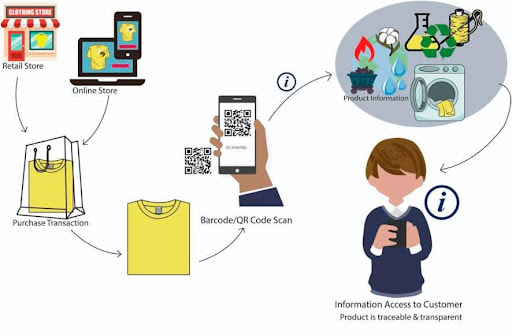Sustainability in the Supply Chain
By: Aryan Janmejay & Reshmi Rajan
Fig: Blockchain application at a store through QR code
Majority of fashion brands these days run on a high-volume low-price model that helps them generate vast amounts of revenue, but it comes at the expense of overproduction and environmental pollution. These problems are further exacerbated by the labour force in the fashion industry being treated as a commodity that can be bought, sold, and controlled in an unethical manner contributing to the negative community and social impacts. The fashion industry should engage in public disclosure of credible and comparable information about their business practices, worker conditions, and socio-environmental impacts of operations. Though this solution is a drop in the bucket for the fashion industry’s sustainable transition, it provides visibility into the processes and conditions through which our clothes are made.
One of the ways to increase transparency and accountability in the fashion industry is through the implementation of extended producer responsibility (EPR). EPR is defined as an environmental policy in which a producer’s responsibility for a product is extended to the post-consumer stage of its life cycle. Through policies like these, fashion companies can be held responsible for increasing transparency and disclosures around their production practices while also being held accountable for the end-of-life phase of their product. EPR policies have been attributed to positively impacting the environment and communities as they lead to curbing overproduction, encouraging companies to produce better products, and leading to an increase in practices around recycling and circularity. Currently, France is the only country in the world that has implemented EPR for end-of-use clothing, linen, and shoes. This has led to a massive increase in the collection and recycling rates of post-consumer textiles, and significantly increased material recovery rates in the country. Other countries should follow suit and consider implementing EPR policies to increase transparency and accountability in the fashion industry to promote sustainability and responsible production.
EPR policies can be further strengthened through the adoption of blockchain technology. Fashion supply chains are predominantly linear which makes information exchange between parts of the chain extremely difficult. Blockchain technology helps eliminate the linearity and opens communication between all parts of the supply chain leading to effective flow of data and information. In a nutshell, blockchain technology helps increase production traceability which is an integral part for EPR policies to be successful. However, this technology is not cheap and is highly energy intensive which might not be accessible by every company looking to create change.
The figure below shows the mapping of blockchain technology applications using QR codes to enhance consumer experience and improve the transparency and traceability of a company’s products. While the clothing article is being produced, the company can attach a tag with a QR code to the product which when scanned by the customer provides information regarding every part of the product’s supply chain. This information pool is brought together through the use of blockchain technology as it gathers data from different nodes in the chain and feeds it to a central universally accessible platform. This technology has been implemented to great success by several companies in the past, such as Chronicled and Provenance for the fashion house of Martine Jarlgaard. Implementation of this initiative by other fashion brands can aid in increasing supply chain transparency while also increasing the affinity customers have with the clothes they buy.
One of the ways to increase transparency and accountability in the fashion industry is through the implementation of extended producer responsibility (EPR). EPR is defined as an environmental policy in which a producer’s responsibility for a product is extended to the post-consumer stage of its life cycle. Through policies like these, fashion companies can be held responsible for increasing transparency and disclosures around their production practices while also being held accountable for the end-of-life phase of their product. EPR policies have been attributed to positively impacting the environment and communities as they lead to curbing overproduction, encouraging companies to produce better products, and leading to an increase in practices around recycling and circularity. Currently, France is the only country in the world that has implemented EPR for end-of-use clothing, linen, and shoes. This has led to a massive increase in the collection and recycling rates of post-consumer textiles, and significantly increased material recovery rates in the country. Other countries should follow suit and consider implementing EPR policies to increase transparency and accountability in the fashion industry to promote sustainability and responsible production.
EPR policies can be further strengthened through the adoption of blockchain technology. Fashion supply chains are predominantly linear which makes information exchange between parts of the chain extremely difficult. Blockchain technology helps eliminate the linearity and opens communication between all parts of the supply chain leading to effective flow of data and information. In a nutshell, blockchain technology helps increase production traceability which is an integral part for EPR policies to be successful. However, this technology is not cheap and is highly energy intensive which might not be accessible by every company looking to create change.
The figure below shows the mapping of blockchain technology applications using QR codes to enhance consumer experience and improve the transparency and traceability of a company’s products. While the clothing article is being produced, the company can attach a tag with a QR code to the product which when scanned by the customer provides information regarding every part of the product’s supply chain. This information pool is brought together through the use of blockchain technology as it gathers data from different nodes in the chain and feeds it to a central universally accessible platform. This technology has been implemented to great success by several companies in the past, such as Chronicled and Provenance for the fashion house of Martine Jarlgaard. Implementation of this initiative by other fashion brands can aid in increasing supply chain transparency while also increasing the affinity customers have with the clothes they buy.


 RSS Feed
RSS Feed
